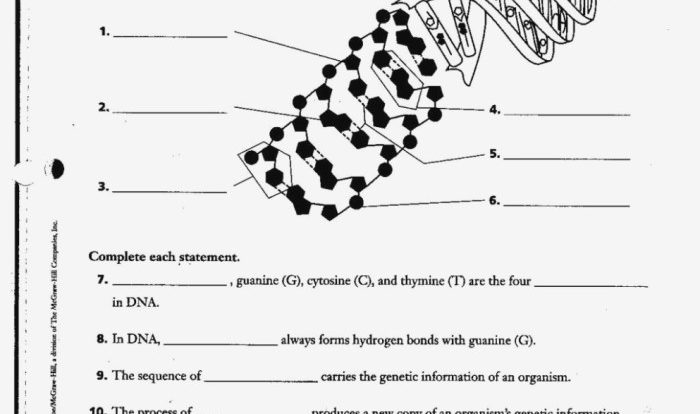Complete the following vocabulary exercise related to DNA replication and delve into the fascinating world of genetics. This exercise will provide you with a comprehensive understanding of the key terms associated with this fundamental biological process.
DNA replication, the process by which cells duplicate their genetic material, is essential for cell division and the transmission of genetic information. By completing this vocabulary exercise, you will gain a deeper appreciation for the intricate mechanisms that govern DNA replication and its significance in living organisms.
DNA Replication Vocabulary Exercise

The purpose of this vocabulary exercise is to enhance your understanding of the key terms related to DNA replication, a fundamental process in molecular biology. DNA replication ensures the accurate duplication of genetic information during cell division, transmitting genetic material from one generation to the next.
By completing this exercise, you will reinforce your knowledge of the vocabulary associated with DNA replication, which is essential for comprehending the mechanisms and significance of this biological process.
Key Vocabulary Terms
- DNA Replication:The process of duplicating DNA, resulting in two identical copies.
- Helicase:An enzyme that unwinds the double helix of DNA during replication.
- DNA Polymerase:An enzyme that synthesizes new DNA strands complementary to the template strands.
- Leading Strand:The newly synthesized DNA strand that is synthesized continuously in the 5′ to 3′ direction.
- Lagging Strand:The newly synthesized DNA strand that is synthesized discontinuously in short fragments called Okazaki fragments.
- DNA Ligase:An enzyme that joins the Okazaki fragments on the lagging strand to form a continuous DNA strand.
- Origin of Replication:The specific DNA sequence where DNA replication begins.
- Replication Fork:The Y-shaped region where DNA replication is actively occurring.
Vocabulary Exercise Completion
To complete the vocabulary exercise, fill in the blanks with the correct vocabulary term from the list provided:
- The enzyme that unwinds the DNA double helix during replication is __________.
- The newly synthesized DNA strand that is synthesized continuously is called the __________.
- The enzyme that synthesizes new DNA strands is __________.
- The specific DNA sequence where DNA replication begins is called the __________.
- The Y-shaped region where DNA replication is actively occurring is the __________.
Example Completion Table, Complete the following vocabulary exercise related to dna replication
| Blank | Correct Answer |
|---|---|
| 1 | Helicase |
| 2 | Leading Strand |
| 3 | DNA Polymerase |
| 4 | Origin of Replication |
| 5 | Replication Fork |
Additional Examples
- Primase:An enzyme that synthesizes short RNA primers to initiate DNA synthesis.
- Telomere:A protective cap at the ends of chromosomes that prevents DNA degradation.
- Semiconservative Replication:The process of DNA replication where each new DNA molecule consists of one original strand and one newly synthesized strand.
Exercise Variation: Crossword Puzzle
Across:
- 1. Enzyme that unwinds DNA (6 letters) HELICASE
- 3. Newly synthesized DNA strand synthesized continuously (9 letters) LEADING STRAND
- 5. Enzyme that joins Okazaki fragments (6 letters) DNA LIGASE
Down:
- 2. Enzyme that synthesizes new DNA strands (12 letters) DNA POLYMERASE
- 4. Specific DNA sequence where replication begins (13 letters) ORIGIN OF REPLICATION
Conclusion: Complete The Following Vocabulary Exercise Related To Dna Replication

Understanding the vocabulary related to DNA replication is essential for comprehending the mechanisms and significance of this fundamental biological process. This vocabulary exercise has provided you with a comprehensive list of key terms and definitions, reinforcing your understanding of DNA replication and its associated terminology.
Top FAQs
What is the purpose of DNA replication?
DNA replication is the process by which cells duplicate their genetic material, ensuring the faithful transmission of genetic information during cell division.
What are the key steps involved in DNA replication?
DNA replication involves several key steps, including DNA unwinding, primer synthesis, DNA polymerase-mediated nucleotide addition, and DNA ligation.
Why is DNA replication important?
DNA replication is essential for cell division, growth, and development, as it ensures that each new cell receives a complete copy of the genetic material.

